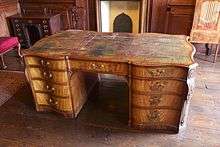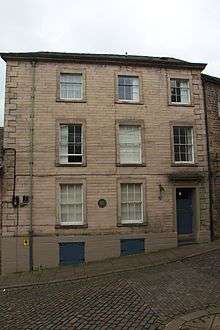Gillows of Lancaster and London
Coordinates: 54°03′00″N 2°48′13″W / 54.04999°N 2.80359°W Gillows of Lancaster and London, also known as Gillow & Co., was a furniture making firm based in Lancaster, Lancashire, and in London. It was originally founded around in Lancaster in about 1730 by Robert Gillow (1704-1772).[1]

Gillows was owned by the family until 1814 when it was taken over by Redmayne, Whiteside, and Ferguson; they continued to use the Gillow name. Gillows furniture was a byword for quality, and other designers used Gillows to manufacture their furniture. Gillows furniture is referred to by Jane Austen, Thackeray and the first Lord Lytton, and in one of Gilbert and Sullivan's comic operas.[3][lower-alpha 1] In 1903, Gillows merged with Warings of Liverpool to become Waring and Gillow and although the furniture remained of a high quality it was not as prestigious.
History
By the mid 1700s, the firm was one of the leading cabinet-makers in Lancaster.[4] They had a reputation for manufacturing very high quality furniture.[1][5] By the end of the 1700s, most of the firm's partners were based in London.[6] The firm merged with a Liverpool firm in 1897 to form Waring & Gillow.
Gillow family (1728- 1814)
In 1728, Robert Gillow began trading in Lancaster as a joiner, builder, house carpenter, furniture maker and overseas merchant. By the summer of 1731 he had entered into a partnership with fellow catholic, George Haresnape, which had ended by 1735.[7] By 1734 six other names appeared on their staff list.[8] Gillows notably made heavy use of mahogany wood, which is indigenous to the Americas, from the early 1730s.[7] In the early 1740s, Gillow owned a twelfth share of the ship Briget, which he partially used to import mahogany from the West Indies. The success of the firm was partly due to his ability to directly import mahogany; by 1742 Gillow was exporting finished mahogany furniture back to the West Indies.[9]
On 1 January 1757, Robert entered into an equal partnership with his son Richard Gillow (1733-1811), and the firm was known as Robert Gillow & Son. Richard was also the architect for several buildings in Lancaster.[10] He financed the building of the catholic church in Dalton Square, Lancaster in 1798. The family's Catholic history [lower-alpha 2] was important in building up a customer base within Lancashire's gentry, and their subsequent purchase of Leighton Hall, Lancashire from a cousin in 1822.[11] On 31 December 1768, Robert Gillow I retired, and left his share of the firm to his other son, Robert Gillow II (1747-1795).[12] In 1769 and 1770, a shop at 176 Oxford Street, London was sent up by the brothers' cousin, Thomas Gillow (1736-1779), to sell their furniture.[13] Goodison and Hardy state that the firm opened a London branch in 1760 at 176 Oxford Road. By 1775 the Lancaster branch had 42 employees, and by 1789 there were about 50 employees.[8]
Leonard Redmayne, Whiteside, and Ferguson (1814-1897)
By 1814 the firm had been taken over by a partnership of Leonard Redmayne, Whiteside, and Ferguson; they continued to use the Gillow name. Redmayne was mayor of the City of Lancaster in 1824, and then in 1826 he became the first chairman of the Lancaster Banking Company, a position he held until 1860.[14][15] The Lancaster Banking company, after a series of acquisitions and mergers would eventually form part of NatWest, who still occupy the original Lancaster Banking Company building.[15] Under the direction of Redmayne, Whiteside, and Ferguson the company expanded from furniture design and bespoke manufacture to being an interior design company that would manufacture furniture and supply other manufacturers products. They were the largest company of its type outside London; where they maintained showrooms and workshops. They had a solid reputation for quality.
The company won commissions to furnish and decorate public buildings in Australia, South Africa, India, Russia, Germany, France and the U.S.. It provided furniture for aristocratic houses, such as Tatton Hall, where some 150 extant pieces complement the work of the architect Lewis William Wyatt.[16][17] Details of the commissions can be found in the Pattern Books in the Gillow archives.
By 1897, they were over extended and formed an informal partnership with Warings of Liverpool. In 1903 they were bought out by Warings and the two companies became Waring & Gillows.[18]
Waring & Gillows (1903-1990)
Waring and Gillow, marked their work using a brass plate instead of stamping the piece: in the merger they lost their reputation for quality. The company survived by fitting out luxury liners until health and safety concerns reduced the use of wood onboard ship. They made Art Deco furniture. In 1962 they were taken over by Great Universal Stores and the Lancaster workshops closed. In 1980 Maple & Co. merged with Waring & Gillow and Maple, Waring & Gillow became part of the Allied Maples Group in 1990. [18]
Legacy
Pieces of Gillow furniture can now be seen in museums in London, Leeds, Adelaide, Melbourne, and Auckland, as well as a collection in the Gillow Museum in the Judges' Lodgings, Lancaster.[1] The furniture can also be seen in houses open to the public such as Tatton Park.
Gillow Archive
The Gillow archives are one of the largest and longest collection of records of any cabinet-maker to have survived.[19] The Gillow pattern book was never published, while Thomas Chippendale's published his pattern book in 1754, Hepplewhite (posthumously) in 1788 and Sheraton in 1791;[20] Gillows would supply pieces in any of these styles. The archive includes their sketches and detailed estimates written in a phonetic north country English.
People
- Robert Gillow I (1704-1772) - Founded the firm, and retired at the end of 1768.
- Richard Gillow (1733-1811) - Son of Robert I, trained as an architect, became partner at the start of 1757.
- Robert Gillow II (1747-1795) - Son of Robert I, became partner at the start of 1769.
- Thomas Gillow (c.1736-1779) - Son of George Gillow, who was a brother of Robert I, set up London branch of firm.

.
Between 1731 and 1850 about 137 apprentices were bound almost exclusively to the firm in Lancaster.[22] George Hepplewhite may have started his working life in the 1750s as an apprentice to Robert Gillow.[23]
Stamps
Gillow stamped much of the furniture they produced, although some items were not stamped, for example picture frames.[24]
| Dates | Stamp |
|---|---|
| 1770- 1780 | Gillow and Taylor |
| 1780- c.1850 | "Gillows Lancaster" |
| c.1850- c.1870 | "Gillow" |
| c.1870- c.1890 | L, followed by a reference number then, "Gillows Lancaster" |
| c.1890- c.1903 | "Gillow & Co" |
| 1903 onwards | "Waring & Gillow" on thin brass plaque |
Gillows stamps.[18]
See also
References
Footnotes
- ↑ H.M.S. Pinafore (1878): Josephine, Captain Corcoran's daughter, sings of "papa's luxurious home" full of "rich oriental rugs, luxurious sofa pillows, and everything that isn't old, from Gillows".
- ↑ Robert Gillowś father had been imprisoned in Lancaster Castle during the 1720s for hiding a priest
Notes
- 1 2 3 Boynton 1995.
- ↑ Library Table Accession Number LANMS.1994.127
- ↑ Apter-Fredericks 2014.
- ↑ Nicholas Goodison and John Hardy (1970). "Gillows at Tatton Park". The Furniture History Society. JSTOR 23401716.
- ↑ Gillow's: Its history & associations. Harrison and Son, London. 1901.
- ↑ Stuart 2008, p. 20.
- 1 2 Stuart 2008, p. 25.
- 1 2 Stuart 2008, p. 78.
- ↑ Adam Bowett. "The English Mahogany Trade 1700 -1793" (PDF). Brunel University (PhD thesis).
- ↑ Andrew White (2000). The buildings of Georgian Lancaster. Centre for North-West regional studies, University of Lancaster.
- ↑ "The Gillow Family". Leighton Hall, Lancashire. Retrieved 20 September 2014.
- ↑ Stuart 2008, p. 47.
- ↑ Stuart 2008, p. 57.
- ↑ "Former Mayors of the City of Lancaster". lancaster.gov.uk. Retrieved 24 September 2014.
- 1 2 "Lancaster Banking Company". banking-history.co.uk. Retrieved 25 September 2014.
- ↑ Colvin 1995, pp. "Wyatt, Lewis William".
- ↑ Stuart, Susan E. (2004), "Gillow family (per. c.1730–c.1830)", Oxford Dictionary of National Biography, Oxford University Press, doi:10.1093/ref:odnb/67319, retrieved 6 November 2014 (subscription or UK public library membership required)
- 1 2 3 Dunn 2008.
- ↑ "The Gillow Family". Leighton Hall, Lancashire. Retrieved 20 September 2014.
- ↑ "George Hepplewhite Facts". Encyclopedia of World Biography. The Gale Group. 2010. Retrieved 18 October 2014.
- ↑ "1 Castle Hill". Retrieved 19 October 2014.
- ↑ Stuart 2008, p. 71.
- ↑ "Hepplewhite 1778-1792". FurniturEbuying.com. 2014. Retrieved 18 October 2014.
- ↑ Stuart, Susan E., ‘Part 2: Picture Frames’, in Gillows of Lancaster and London, 1730-1840: Cabinetmakers and International Merchants: A Furniture and Business History, vol. 2, Woodbridge, 2008, pp.34-45,
Bibliography
- Boynton, Lindsay (1995). Gillow Furniture Designs: 1760-1800. The Bloomfield Press.
- Dunn, Judith (2008). "Gillows of Lancaster Two Centuries of English Furniture". New England Antiques Journal. Palmer, MA 01069.
- Stuart, Susan E (2008). Gillows of Lancaster and London. Antique Collectors' Club.
- Colvin, Howard (1995), A Biographical Dictionary of British Architects, 1600-1840 (3rd ed.), New Haven and London: Yale University Press, ISBN 978-0-300-12508-5
External links
| Wikimedia Commons has media related to Gillows of Lancaster and London. |